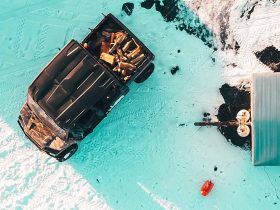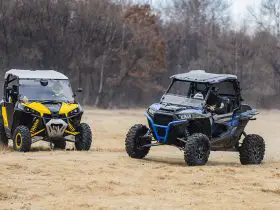It is always an exciting time for enthusiasts and off-roaders when it is the sand season in Southern California. Incidentally, this place is where the biggest sand dunes are located right at the heart of the Imperial Sand Dune Recreation Area, also known as Glamis. Along with the usual safety precautions that we do whenever riding off-road vehicles, is the question of how we can keep the sand out of the cab of our UTV, as well as keeping it out of our faces.
Table of Contents
What Makes Dust and Sand Swirl Inside Your Cab?
There are Two Things that makes for a dusty swirly cabin:
• Open Sides
no doors, or partial doors
• Airflow
Swirling dust and sand largely depends on the strength of the airflow inside the cab. Furthermore, airflow is also dependent on the windshield if any, that is installed. How we manage to disrupt the airflow is the key to keeping dust out of your cab.
First, let us look into how a type of windshield or no windshield can drastically change the airflow that is coming into your UTV.
No Windshield
In this case, we will be talking about no windshield from both front and back. There are also no lower door inserts to plug the holes right below the partial doors. What happens is that a UTV with no windshield will cause the airflow to go straight into the cab and exit straight out of the back as well.
Since the air is free to flow in and out of the cab, having no windshield is perfect for a UTV that is cruising at a good speed. The thing is, whenever the vehicle slows down or stops, dust can become a cloud that settles inside of your cab. Other than that, this set up is okay for drivers who would rather have the wind in their faces, as they tend to appreciate the outdoors better with an unimpeded view. Don’t forget to put on a pair of goggles for eye protection.
Goggles
This type of protection is highly recommended regardless of what type of solution you are going to use. With either a windshield or no windshield situation, you will need goggles to protect your eyes from dust and sand. Tiny specks are no fun to remove if it gets in your eyes. It is painful too.
For the moment there is no substitute for a pair of trusty goggles, not even your favorite sunglasses. There are too many spaces in between them that you will still get sand in your eyes. Take care to buy not just the regular ones but choose the special sand goggles.
Sand goggles contain extra foam or have smaller foam cells to prevent tiny sand particles from getting through it. A good reason to choose sand goggles is when you are riding your UTV and cresting peaks, you will have the sun coming down on your face in awkward angles. Without sand goggles, dust and squinting may severely affect your vision.
It would also be good to have two sets of sand goggles, tinted and non-tinted. For protection from glare.

Scott Goggles suitable for dusty UTV rides
Goggles combined with dust mask
Some goggles are combined with a face mask to protect you from dust and sand. Check out the Wolfsnout Dust Masks & Goggles.
Dust Mask
Before donning on goggles you might want to put on a face mask. A face mask could be anything from a simple t-shirt to a specially manufactured contraption that easily looks like a mask that covers both the nose and the mouth. It is then securely strapped all the way to the back of the head.
A professional dust mask may contain a pair of filters that will ultimately keep out 99% of dust particles. The cloth itself is made of stretchable material that will fit various head sizes. Other than the state of California, some other states do allow just a combination of dust masks and goggles.
You can also wear a dust mask right inside your dirt-bike style helmet whenever required. One other thing you can wear is a Motley Tube, a breathable, moisture-wicking polyester that you can wear any day at any time. It’s a versatile cloth that you can wear as a dust mask covering your mouth nose, and ears. You can also wear it for other purposes like a scarf, neck warmer, etc.

Simple and efficent scarf as face mask
Half a Windshield
Using half a windshield is an effective way of avoiding wind from hitting your chest and your face. Half means just a portion of the lower part of the frame of your UTV is covered. Most of the airflow blows right over your head and even affords you some protection from the nippy air on colder days.
What happens is that the airflow along with the dust blows overhead and continues on all the way to the back. The dust doesn’t settle inside the cab, instead, it shoots all the way to the back and outside of the vehicle. Since half of the front is already covered, it then creates a partial vacuum pulling in air from both the sides and back of the UTV.
What it does is create a partial swirl that would probably bother some drivers and some that wouldn’. In any case, a half a windshield would be a great idea for warmer months wherein a breeze would feel warm and welcoming.
Since this solution is only half a windshield, airflow blows right over the head of the driver and blows right through to the rear passenger. Not really a good option for colder climates. The rear passenger might freeze because of the cold wind.
This type of windshield is also great for 2 seater UTVs. If the holes below the partial doors aren’t plugged in, chances are dust will enter the cab and even a partial or a full windshield won’t even matter. So, take the time to cover those holes and you will want to supply helmets to your passengers sitting at the back whenever you are driving a 4 seater.
This is so that you could have them protected from drafts or even from dust landing on the head.
Helmet
It is important to note that in the great state of California, any passenger who rides in any SXS will have to wear a helmet. This is especially when driving on public lands. That goes for everyone who is looking to drive a UTV in any of the states, Look into the requirements first and make sure that it is DOT approved.
A helmet not only protects a driver or passenger in accidents but it can also be a direct cover from dust and sand. It could be a dirt-bike style helmet or any other style as long as it covers most parts of your head.
Full Windshield
It would make sense to assume that a full windshield since it blocks all the airflow, will keep you warm. After all, any four-wheeled vehicle like a regular car can benefit from being covered by a full windshield. And we think that the same principle would apply to a UTV. Unfortunately, it is not the case with your open-air UTV.
You see, when you fully block the airflow from the front by putting a barrier like a windshield, it creates a strong vacuum, pulling the air from all sides of the open UTV. In fact, it is attracting at the strongest instance of dust and sand from the open sides, even all the way to the back. You can almost expect to be covered with sand by the time you arrive at your destination.
We can conclude that full windshield is the least effective solution in avoiding dust and sand from accumulating inside your cab. In fact, you can expect your cab to look like a dustbin if you go this route.
Flip-Up Windshield With a Rear Window Panel
Using this solution is by far the best you can do to your UTV and yourself. Finally, you get to solve the problem of dust and sand accumulating inside your cab. It features a combination of a flip-up front windshield together with a rear panel that covers the whole of the back of the vehicle. Picture this: you have a windshield that is propped up and forward by sturdy gas hydraulics. At the same time, a rear panel is covering the back of the UTV.
It creates a repelling airflow pushing the air away from the cab and going out from the sides of the vehicle. So instead of attracting dust and sand, it lets it escape out from the sides of the vehicle. This is not a perfect set up as some dust may still get in. But by far, this the most effective at repelling more dust and sand than all the other alternatives we mentioned above.
Bottom line, dust, and sand are part of the off-roading lifestyle that can be for everyone, or maybe not everyone. Some trails may be more difficult than others, some a little bit dustier, and the main point is you are safe and protected with the application of the solutions in this article. That means you can gear up and have fun while minimizing the risk maximizing the benefits of protecting yourself and your family.
More importantly, you can adjust your windshield according to what position it is best for the day. A fully propped-up windshield could mean a dusty trip, or just a little adjustment of the flip-up windshield to cool off on a hot day. Drive safe, be comfortable, and don’t let it get into your eyes.
You can check out more info about fun in the article sand dune and desert riding tips.









